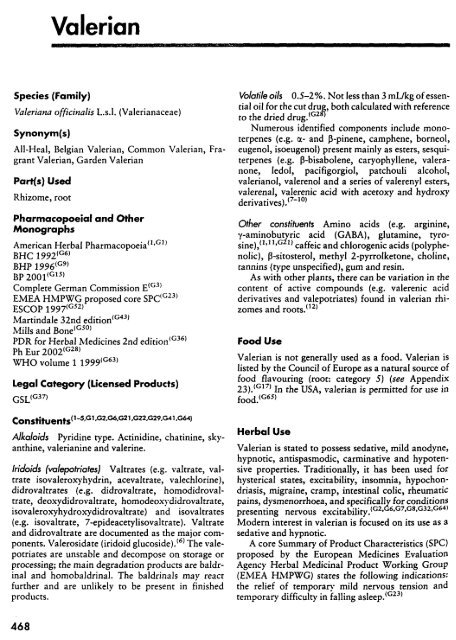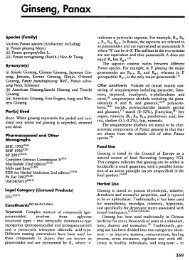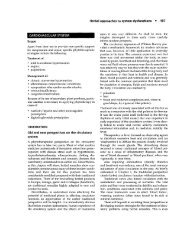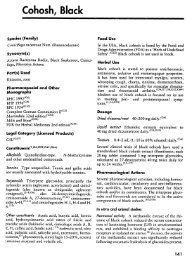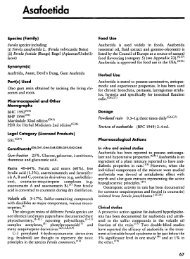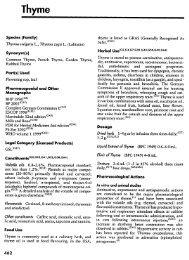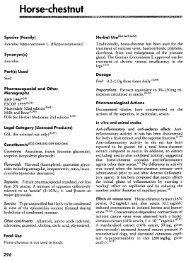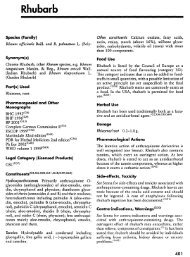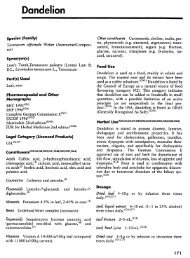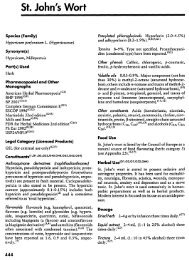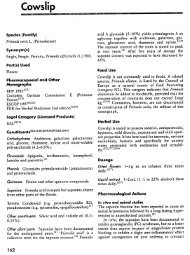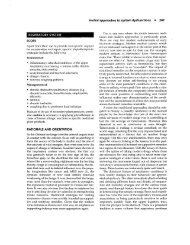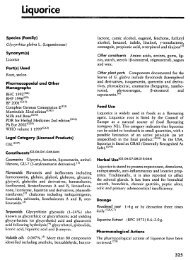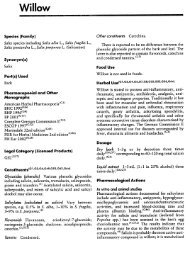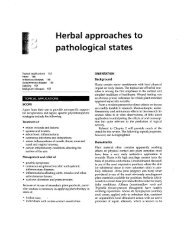Valerian
Valerian
Valerian
You also want an ePaper? Increase the reach of your titles
YUMPU automatically turns print PDFs into web optimized ePapers that Google loves.
<strong>Valerian</strong><br />
Species (Family)<br />
<strong>Valerian</strong>a o<br />
Synonym(s)<br />
icinalis L .s.l . (<strong>Valerian</strong>aceae)<br />
All-Heal, Belgian <strong>Valerian</strong>, Common <strong>Valerian</strong>, Fragrant<br />
<strong>Valerian</strong>, Garden <strong>Valerian</strong><br />
Part(s) Used<br />
Rhizome, root<br />
Pharmacopoeial and Other<br />
Monographs<br />
American Herbal Pharmacopoeia (1,GI)<br />
BHC 1992 (G6)<br />
BHP 1996 (G9)<br />
BP 2001 (G1s)<br />
Complete German Commission E (G3)<br />
EMEA HMPWG proposed core SPC (G23)<br />
ESCOP 1997 (G52)<br />
Martindale 32nd edition (G43)<br />
Mills and Bone (G50<br />
PDR or Herbal Medicines 2nd edition (G36)<br />
Ph Eur 2002 (G28)<br />
WHO volume 1 1999 (G63)<br />
Legal Category (Licensed Products)<br />
GSLV G37)<br />
Constituents(l 's ,G1,G2,G6,G21,G22,G29,G41,G64)<br />
Alkaloids Pyridine type . Actinidine, chatinine, skyanthine,<br />
valerianine and valerine .<br />
lridoids (vatepotriotes) Valtrates (e .g . valtrate, valtrate<br />
isovaleroxyhydrin, acevaltrate, valechlorine),<br />
didrovaltrates (e .g . didrovaltrate, homodidrovaltrate,<br />
deoxydidrovaltrate, homodeoxydidrovaltrate,<br />
isovaleroxyhydroxydidrovaltrate) and isovaltrates<br />
(e .g. isovaltrate, 7-epideacetylisovaltrate) . Valtrate<br />
and didrovaltrate are documented as the major components<br />
. Valerosidate (iridoid glucoside) . ( 6) The valepotriates<br />
are unstable and decompose on storage or<br />
processing; the main degradation products are baldrinal<br />
and homobaldrinal . The baldrinals may react<br />
urther and are unlikely to be present in inished<br />
products .<br />
Volatile oils 0.5-2% . Not less than 3 mL/kg o essential<br />
oil or the cut drug, both calculated with re erence<br />
to the dried drug . (G28)<br />
Numerous identi ied components include monoterpenes<br />
(e .g . a- and 0-pinene, camphene, borneol,<br />
eugenol, isoeugenol) present mainly as esters, sesquiterpenes<br />
(e .g . (3-bisabolene, caryophyllene, valeranone,<br />
ledol, paci igorgiol, patchouli alcohol,<br />
valerianol, valerenol and a series o valerenyl esters,<br />
valerenal, valerenic acid with acetoxy and hydroxy<br />
derivatives) . (7-10)<br />
Other constituents Amino acids (e .g. arginine,<br />
y-aminobutyric acid (GABA), glutamine, tyrosine),("'<br />
1,G21) ca eic and chlorogenic acids (polyphenolic),<br />
j3-sitosterol, methyl 2-pyrrolketone, choline,<br />
tannins (type unspeci ied), gum and resin .<br />
As with other plants, there can be variation in the<br />
content o active compounds (e .g. valerenic acid<br />
derivatives and valepotriates) ound in valerian rhizomes<br />
and roots . (12)<br />
Food Use<br />
<strong>Valerian</strong> is not generally used as a ood . <strong>Valerian</strong> is<br />
listed by the Council o Europe as a natural source o<br />
ood lavouring (root: category 5) (see Appendix<br />
23) . (G17) In the USA, valerian is permitted or use in<br />
ood. (G65)<br />
Herbal Use<br />
<strong>Valerian</strong> is stated to possess sedative, mild anodyne,<br />
hypnotic, antispasmodic, carminative and hypotensive<br />
properties . Traditionally, it has been used or<br />
hysterical states, excitability, insomnia, hypochondriasis,<br />
migraine, cramp, intestinal colic, rheumatic<br />
pains, dysmenorrhoea, and speci ically or conditions<br />
excitability .(G2,G6,G7,G8,G32,G 64)<br />
presenting nervous<br />
Modern interest in valerian is ocused on its use as a<br />
sedative and hypnotic .<br />
A core Summary o Product Characteristics (SPC)<br />
proposed by the European Medicines Evaluation<br />
Agency Herbal Medicinal Product Working Group<br />
(EMEA HMPWG) stares the ollowing indications :<br />
the relie o temporarv mild nervous tension and<br />
temporary di iculty in alling asleep . (G23)<br />
468
<strong>Valerian</strong> 469<br />
Dosage<br />
Dried rhizome/root 1- g<br />
by infusion or decoction<br />
up to three times daily . (G6<br />
Tincture -5mL (1 :5 ; 70% ethanol) up to three<br />
times daily ; (G6,G50) 1- mL, once to several times<br />
daily. (G )<br />
Extracts Amount equivalent to 2- g drug, once to<br />
several times daily-, ) 2-6 mL of 1 : 2 liquid extract<br />
daily. (GSO)<br />
Doses given in older texts vary . For example :<br />
<strong>Valerian</strong> Liquid Extract (BPC 196 ) 0 . -1 .0 mL ;<br />
Simple Tincture of <strong>Valerian</strong> (BPC 1949) 4-8 mL ;<br />
Concentrated <strong>Valerian</strong> Infusion (BPC 196 ) 2-4mL .<br />
Clinical trials investigating the effects of valerian<br />
extracts on sleep parameters have used varying<br />
dosages, for example, valerian extract 400 mg/day<br />
(drug : extract ratio of :1) (1 ) to 1215 mg/day<br />
(drug : extract ratio of S to 6 : 1) . (14)<br />
Pharmacological Actions<br />
It remains unclear precisely which of the constituents<br />
of valerian are responsible for its sedative properties<br />
. (' ) Attention had focused on the volatile oil, and<br />
then the valepotriates and their degradation products,<br />
as the constituents responsible . However, it appeared<br />
that the effects of the volatile oil could not account for<br />
the whole action of the drug, and the valepotriates,<br />
which degrade rapidly, are unlikely to be present in<br />
finished products in significant concentrations . Current<br />
thinking is that the overall effect of valerian is due<br />
to several different groups of constituents and their<br />
varying mechanisms of action . Therefore, the activity<br />
of different valerian preparations will depend on their<br />
content and concentrations of several types of constituent.<br />
(4) One mechanism of action is likely to involve<br />
increased concentrations of the inhibitory transmitter<br />
GABA in the brain . Increased concentrations of<br />
GABA are associated with a decrease in CNS activity<br />
and this action may, therefore, be involved in the<br />
reported sedative activity .<br />
In vitro and animal studies<br />
Sedative properties have been documented for valerian<br />
and have been attributed to both the volatile oil<br />
and valepotriate fractions . (15 .16) Screening of the<br />
volatile oil components for sedative activity concluded<br />
valerenal and valerenic acid to be the most<br />
active compounds, causing ataxia in mice at a dose of<br />
50mg/kg by intraperitoneal injection! 151 Further<br />
studies in mice described valerenic acid as a general<br />
CNS depressant similar to pentobarbitone, requiring<br />
high doses (100mg/kg by intraperitoneal injection)<br />
for activity . (17) A dose of 400 mg/kg resulted in muscle<br />
spasms, convulsions and death ."' ) Valerenic acid was<br />
also reported to prolong pentobarbitone-induced<br />
sleep in mice, resulting in a hangover effect. Biochemical<br />
studies have documented that valerenic acid<br />
inhibits the enzyme system responsible for the central<br />
catabolism of GABA .M 18) An aqueous extract of roots<br />
and rhizomes of V officinalis (standardised to 55 mg<br />
valerenic acids per 100 g extract) inhibited the uptake<br />
and stimulated the release of radiolabelled GABA in<br />
isolated synaprosomes from rat brain cortex . (19,20)<br />
Further work suggested that this aqueous extract of<br />
valerian induces the release of GABA by reversal of the<br />
GABA carrier, and that the mechanism is Na' dependent<br />
and Ca t, independent . (20) The extract contained<br />
a high concentration of GABA (about 5 mmol/L)<br />
which was shown to be sufficient to induce the release<br />
of radiolabelled GABA by this type of mechanism . (21)<br />
Aqueous and hydroalcoholic (ethanol) extracts of<br />
valerian root displaced radiolabelled muscimol binding<br />
to synaptic membranes (a measure of the influence<br />
of drugs on GABAA receptors) . However, valerenic<br />
acid (0 .1 mmol/L) did not displace radiolabelled muscimol<br />
in this model .' 22) Other in vitro studies using rat<br />
brain tissue have shown that hydroalcoholic and<br />
aqueous total extracts of V. officinalis root, and an<br />
aqueous fraction derived from the hydroalcoholic<br />
extract, show affinity for GABA A receptors, although<br />
far lower than that of the neurotransmitter itself . )<br />
However, a lipophilic fraction of the hydroalcoholic<br />
extract, hydroxyvalerenic acid and dihydrovaltrate<br />
did not show any affinity for the GABAA receptor in<br />
this model .<br />
The effects of valerian extracts on benzodiazepine<br />
binding to rat cortical membranes have also been<br />
explored . Very low concentrations of ethanolic<br />
extract of V officinalis had no effect on radiolabelled<br />
flunitrazepam binding in this model, although<br />
concentrations of 10 -10 to 10 -8 mg/mL increased<br />
radiolabelled flunitrazepam binding with an EC50<br />
of 4 .1 x 10 -10 mg/mL . (24) However, flunitrazepam<br />
binding was inhibited at higher concentrations<br />
(0 .5-7 .0 mg/mL) of valerian extract (IC50<br />
4 .82 x 10 -1 mg/mL) . In other investigations, valerian<br />
extract potentiated radiolabelled GABA release<br />
from rat hippocampal slices, and inhibited synaptosomal<br />
GABA uptake, confirming the effects of valerian<br />
extract on GABA A receptors . (24)<br />
CNS-depressant activities in mice following intraperitoneal<br />
injection have been documented for the<br />
valepotriates and for their degradation products,<br />
although activity was found to be greatly reduced<br />
following oral administration . (21) A study explored<br />
the effects of a mixture of valeporriates on the behaviour<br />
of diazepam-withdrawn male Wistar rats in the
470 <strong>Valerian</strong><br />
elevated plus-maze test (a measure of the anxiolytic or<br />
anxiogenic properties of drugs) . (26) Rats were given<br />
diazepam (up to 5 mg/kg for 28 days) then vehicle only<br />
for three days to induce a withdrawal syndrome . Rats<br />
given diazepam or a mixture of valepotriates (dihyritoneally<br />
(12mg/kg) spent a significantly greater<br />
proportion of time in the `open' arms of the maze<br />
than did those in the control group .<br />
Another specific valepotriate fraction, Vpt 2i has<br />
been documented to exhibit tranquillising, central<br />
myorelaxant, anticonvulsant, coronaro-dilating and<br />
anti-arrhythmic actions in mice, rabbits, and<br />
cats. (27 .281 The fraction was reported to prevent<br />
arrhythmias induced by Pituitrin vasopressin and<br />
barium chloride, and to exhibit moderate positive<br />
inotropic and negative chronotropic effects .<br />
Antispasmodic activity on intact and isolated guinea-pig<br />
ileum has been documented for isovaltrate,<br />
valtrate and valeranone . (29) This activity was attributed<br />
to a direct action on the smooth muscle receptors<br />
rather than ganglion receptors . <strong>Valerian</strong> oil has been<br />
reported to exhibit antispasmodic activity on isolated<br />
guinea-pig uterine muscle, (30) but proved inactive<br />
when tested in vivo . (31)<br />
In vitro inactivation of complement activation has<br />
been reported for the valepotriates . (32)<br />
In vitro cytotoxicity (inhibition of DNA and protein<br />
synthesis, and potent alkylating activity) has been<br />
documented for the valepotriates, with valtrate stated<br />
to be the most toxic compound . (33) Valepotriates<br />
(valtrate and didrovaltrate) isolated from the related<br />
species <strong>Valerian</strong> wallichii, and baldrinal (a degradation<br />
product of valtrate) have been tested for their<br />
cytotoxic activity in vitro using cultured rat hepatoma<br />
cells . Valtrate was the most active compound in this<br />
system, leading to a 100% mortality of hepatoma cells<br />
after 24 hours' incubation at a concentration of 33 gg/<br />
mL. (34) More detailed studies using the same system<br />
showed that didrovaltrate demonstrated cytotoxic<br />
activity when incubated at concentrations higher<br />
than 8 pg/mL of culture (1 .5 x 10 -5 mol/L) and led<br />
to 100% cellular mortality with 24 hours of incubation<br />
at a concentration of 66 pg/mL . The cytotoxic<br />
effect of didrovaltrate was irreversible within 2 hours<br />
of incubation with hepatoma cells . In mice, administration<br />
of intraperitoneal didrovaltrate led to a regression<br />
of Krebs II ascitic tumours, compared with<br />
control .(34) A subsequent in vivo study, in which<br />
valtrate was administered to mice (by intraperitoneal<br />
injection and by mouth), did not report any toxic<br />
effects on haematopoietic precursor cells when compared<br />
with control groups. (35) The valepotriates are<br />
known to be unstable compounds in both acidic and<br />
alkaline media and it has been suggested that their in<br />
vivo toxicity is limited due to poor absorption and/or<br />
distribution . (2) Baldrinal and homobaldrinal, decomposition<br />
products of valtrate and isovaltrate respectively,<br />
have exhibited direct mutagenic activity<br />
against various Salmonella strains in vitro . (36)<br />
Clinical studies<br />
Numerous studies have explored the effects of valerian<br />
preparations on subjective and/or objective sleep<br />
parameters . (13,14,37-45) Collectively, the findings of<br />
these studies are difficult to interpret, as different<br />
studies have assessed different valerian preparations<br />
and different dosages, and some have involved healthy<br />
volunteers whereas others have involved patients with<br />
diagnosed sleep disorders . In addition, other studies<br />
have used different subjective and/or objective outcome<br />
measures, and some have been conducted in<br />
sleep laboratories, whereas others have assessed participants<br />
receiving valerian whilst sleeping at home .<br />
Overall, several, but not all, studies have documented<br />
a hypnotic effect for valerian preparations with regard<br />
to subjective measures of sleep quality, and some have<br />
documented effects on objective measures of sleep<br />
structure . There is a view that subjective measures of<br />
sleep quality may be the most appropriate assessment<br />
.<br />
A systematic review of randomised, double-blind,<br />
placebo-controlled trials of valerian preparations<br />
included nine studies . (46) The review concluded that<br />
the evidence for valerian as a treatment for insomnia<br />
is inconclusive and that there is a need for further<br />
rigorous trials . Several of the studies included in the<br />
review, and other studies, are discussed in more detail<br />
below .<br />
A placebo-controlled study involving 128 volunteers<br />
explored the effects of an aqueous extract of<br />
valerian root (400 mg) and a proprietary preparation<br />
of valerian and hops (Hova) on subjective measures of<br />
sleep quality. Each participant took each of the three<br />
preparations at night for three non-consecutive<br />
nights. (13) On the basis of participants' self-assessment,<br />
valerian significantly reduced sleep latency<br />
(time to onset of sleep) and improved sleep quality,<br />
compared with placebo (p < 0 .05) . Subgroup analysis<br />
suggested that the effects of valerian were most<br />
marked among participants who described themselves<br />
as `poor' or `irregular' sleepers . (13) It was<br />
reported that Hova did not significantly affect sleep<br />
latency or sleep quality, compared with placebo, only<br />
that Hova administration was associated with an<br />
increase in the number of reports of `feeling more<br />
sleepy than usual the next morning' (i .e . a 'hangover'<br />
effect) . The authors were unable to explain this<br />
discrepancy in the results for the two preparations .<br />
In a subsequent study, eight volunteers with mild<br />
insomnia each received aqueous valerian extract
<strong>Valerian</strong> 471<br />
450 mg, 900 mg or placebo, in a random-order experimental<br />
design over almost three weeks . (37) The time<br />
to the first period of 5 consecutive minutes without<br />
movement, measured using wrist-worn activity<br />
meters, was used as an objective measure of sleep<br />
latency. For this parameter, valerian 450 mg significantly<br />
reduced the mean sleep latency, compared with<br />
placebo, although there was no further reduction in<br />
sleep latency with valerian 900 mg . Subjective assessments<br />
indicated that participants were more likely<br />
to experience a `hangover' effect with valerian<br />
(37)<br />
900 Mg .<br />
The same dosages of aqueous valerian extract<br />
were tested for their effects on sleep latency and<br />
wake time after sleep onset in healthy volunteers<br />
who were either sleeping at home or in a sleep<br />
laboratory . (38) Each participant sleeping at home<br />
took valerian 450 mg, 900 mg, or placebo, for two<br />
consecutive nights on a double-blind, crossover<br />
schedule . Participants sleeping under laboratory<br />
conditions were randomly assigned to receive valerian<br />
900 mg on the second or third night of the four<br />
nights of the study ; placebo was taken on the other<br />
nights . Under home conditions, valerian 450 mg and<br />
900 mg significantly reduced subjectively measured<br />
sleep latency, compared with placebo . Under laboratory<br />
conditions, there were no statistically significant<br />
differences between valerian 900 mg and placebo on<br />
subjective or objective sleep parameters . It was<br />
suggested that the `more stressful' sleep environment<br />
of the laboratory may have masked the hypnotic<br />
effects of valerian . (38)<br />
A randomised, double-blind, placebo-controlled,<br />
crossover study involving 16 patients with previously<br />
established psychophysiological insomnia<br />
according to International Classification of Sleep<br />
Disorders (ICSD) criteria and confirmed by polysomnography<br />
assessed the effects of single-dose and<br />
longer term administration of valerian root extract<br />
on objective parameters of sleep structure and subjective<br />
parameters of sleep quality . (39) Participants<br />
received valerian root extract (Sedonium ;<br />
drug : extract ratio 5 : 1) 600 mg, or placebo, 1<br />
hour before bedtime for 14 days, followed by a<br />
wash-out period of 13 days, before crossing over to<br />
the other arm of the study . There were no statistically<br />
significant effects on objective and subjective<br />
parameters of sleep following single-dose valerian<br />
administration . After long-term treatment, sleep<br />
efficiency (ratio of time spent asleep to time spent<br />
in bed) improved in both the valerian and placebo<br />
groups, compared with baseline values, although<br />
there were no significant differences between<br />
groups. There was a statistically significant difference<br />
with valerian on parameters of slow-wave<br />
sleep, compared with baseline values, which did<br />
not occur with placebo . However, it is not clear if<br />
this difference was significantly different for valerian,<br />
compared with placebo, as no p-value was<br />
given .<br />
In a randomised, double-blind, pilot study, 14<br />
elderly women who were poor sleepers received<br />
valerian aqueous extract (Valdispert forte ;<br />
drug :extract ratio 5 to 6 : 1), or placebo, for eight<br />
consecutive days . (14) <strong>Valerian</strong> 405 mg was administered<br />
one hour before sleep for one night in the<br />
laboratory, then taken three times daily for the following<br />
seven days . There was no difference in sleep<br />
parameters between valerian extract and placebo after<br />
acute administration . <strong>Valerian</strong> recipients showed an<br />
increase in slow-wave sleep, compared with baseline<br />
values . However, valerian had no effect on sleep onset<br />
time, rapid eye movement (REM) sleep or on selfrated<br />
sleep quality .<br />
Aqueous ethanolic valerian extract (Sedonium)<br />
was compared with placebo in a randomised,<br />
double-blind trial involving 121 patients with<br />
insomnia not due to organic causes . (4) Participants<br />
received valerian extract, or placebo, 600 mg one hour<br />
before bedtime for 28 days . At the end of the study,<br />
valerian extract achieved a significantly higher clinical<br />
global impression score than did placebo . Sleep quality<br />
improved in both groups, compared with baseline<br />
values .<br />
The effects of valerian extracts on sleep parameters<br />
have been compared with those of the benzodiazepine<br />
oxazepam . (41) This randomised, doubleblind<br />
trial involving people with non-organic and<br />
non-psychiatric insomnia compared valerian root<br />
extract 600 mg with oxazepam 10 mg ; treatment<br />
was taken 30 minutes before going to bed for 28<br />
days . At the end of the treatment period, sleep quality<br />
had improved significantly (p < 0 .001) in both<br />
groups, compared with baseline values . There was<br />
no difference between the two groups with regard to<br />
sleep quality .<br />
An open, uncontrolled, multicentre study assessed<br />
the effects of a valerian extract (Baldrian-Dispert)<br />
45 mg daily in 11 168 patients with sleep disorders .<br />
<strong>Valerian</strong> was rated as `good' or `very good' in 72% of<br />
cases of sleep disturbances, 76% of cases of discontinuous<br />
sleep, and in 72% of cases of restlessness and<br />
tension . (42)<br />
Several other studies have assessed the effects of<br />
valerian extract in combination with other herb<br />
extracts, such as hops (Humulus lupulus) and/or<br />
melissa (Melissa officinalis), on measures of<br />
sleep . (47-50) A randomised, double-blind trial involving<br />
healthy volunteers who received Songha Night (V .<br />
officinalis root extract 120 mg and M. officinalis leaf
472 <strong>Valerian</strong><br />
extract 8 mg) three tablets daily taken as one dose 3<br />
minutes before bedtime for 3 days (n=66), or placebo<br />
(n=32), found that the proportion of participants<br />
reporting an improvement in sleep quality was<br />
significantly greater for the treatment group, compared<br />
with the placebo group (33 .3% versus 9.4%,<br />
respectively ; p = . 4) . 48 However, analysis of visual<br />
analogue scale scores revealed only a slight, but<br />
statistically non-significant, improvement in sleep<br />
quality in both groups over the treatment period .<br />
Another double-blind, placebo-controlled trial<br />
involving patients with insomnia who received Euvegal<br />
forte (valerian extract 16 mg and lemon balm<br />
extract 8 mg) two tablets daily for two weeks<br />
reported significant improvements in sleep quality in<br />
recipients of the herbal preparation, compared with<br />
placebo recipients . (49) A placebo-controlled study<br />
involving `poor sleepers' who received Euvegal forte<br />
reported significant improvements in sleep efficiency<br />
and in sleep stages 3 and 4 in the treatment group,<br />
compared with placebo recipients . (5 )<br />
Some studies assessing combination valerian preparations<br />
have compared the effects with those of<br />
benzodiazepines .(51' 2) A three-week, randomised,<br />
double-blind trial reported that a combination of<br />
valerian and hops (2 mg and 45 .5 mg dry extract,<br />
respectively) was equivalent to bromazepam 3 mg<br />
with regard to sleep quality in patients with 'environmental'<br />
sleep disorders (temporary dyscoimesis and<br />
dysphylaxia) according to Diagnostic and Statistical<br />
Manual (DSM)-IV criteria . (" ) A study assessing the<br />
`hangover' effects of valerian preparations (valerian<br />
syrup and valerian-hops tablets) (see Side-effects,<br />
Toxicity) reported that subjective measures of sleep<br />
quality improved in both valerian groups, compared<br />
with placebo . (52)<br />
In an open, uncontrolled, multicentre study, 225<br />
individuals who were experiencing nervous agitation<br />
and/or difficulties falling asleep and achieving uninterrupted<br />
sleep were treated for two weeks with a<br />
combination preparation containing extracts of valerian<br />
root, hop grains and lemon balm leaves . (53)<br />
Significant improvements in the severity and frequency<br />
of symptoms were reported, compared with<br />
the pretreatment period . Difficulties falling asleep,<br />
difficulties sleeping through the night, and nervous<br />
agitation were improved in 89, 8 and 82% of<br />
participants, respectively .<br />
In a single-blind, placebo-controlled, crossover<br />
study involving 12 healthy volunteers, two different<br />
single doses of valerian-hops (valerian 5 mg, hops<br />
12 mg; valerian 15 mg, hops 36 mg) were<br />
assessed for their effects on EEG recordings . (54)<br />
Some slight effects on the quantitative EEG were<br />
documented following administration of higher<br />
dose valerian-hops, indicating effects on the central<br />
nervous system .<br />
The effects of valerian extract 1 mg (no further<br />
details of preparation given) on activation and performance<br />
of 48 healthy volunteers under experimental<br />
social stress conditions have been assessed, with or<br />
without propranolol 2 mg, in a randomised doubleblind,<br />
placebo-controlled study . (55) <strong>Valerian</strong> was<br />
reported to have no influence on physiological activation<br />
and to lead to less intensive subjective feelings of<br />
somatic arousal . The effects of a hydroalcoholic<br />
extract of valerian have been assessed in a randomised<br />
study involving 4 patients with minor symptoms<br />
of anxiety and emotional tension . 6)<br />
Participants received valerian extract 1 mg three<br />
times daily, or placebo, for 21 days . It was reported<br />
that valerian was superior to placebo .<br />
Several other studies have assessed the effects of<br />
combinations of valerian and St . John's wort<br />
(Hypericum perforatum) in patients with anxiety or<br />
depression . (57-59) In a randomised, double-blind study<br />
involving 1 patients with anxiety, a combination of<br />
valerian and St . John's wort was reported to be<br />
significantly more effective than diazepam according<br />
to a physician's rating scale and a patient's self-rating<br />
scale . (5) In a randomised, double-blind trial involving<br />
162 patients with dysthymic disorders, the effects of a<br />
valerian and St . John's wort combination (Sedariston)<br />
were compared with those of amitriptyline 75-<br />
15 mg . (58) Another randomised, double-blind trial,<br />
involving 1 patients with mild-to-moderate depression<br />
compared Sedariston with desipramine 1 -<br />
15 mg. (5) Pooling the results of these two studies<br />
indicated there were 88 (68%) treatment responders<br />
in the Sedariston group and 66 (5 %) in the group that<br />
received standard antidepressants . ( " ) This difference<br />
was not statistically significant .<br />
Several studies have assessed the effects of valerian,<br />
or herbal combination products containing valerian,<br />
on performance the morning after treatment (see Sideeffects,<br />
Toxicity) . (52,61)<br />
Side-effects, Toxicity<br />
Data relating to the safety of valerian have been<br />
reviewed . ("' )<br />
Studies assessing the effects of valerian on measures<br />
of performance suggest that there may be slight<br />
impairment for a few hours following valerian ingestion<br />
. However, studies have shown that `hangover'<br />
effects (impairment of performance the morning following<br />
valerian treatment) do not appear to be a<br />
concern .<br />
In a randomised, double-blind trial involving 1 2<br />
healthy volunteers, the effects of single-dose valerian
ValerƐan 473<br />
extract (SedonƐum) 600 mƐ on reactƐon tƐme, alertness<br />
and concentratƐon were compared wƐtƐ tƐose oƐ<br />
ƐlunƐtrazepam 1 mƐ and placebo . (61 ? TƐe treatment<br />
was admƐnƐstered Ɛn tƐe evenƐnƐ and psycƐometrƐc<br />
tests were carrƐed out tƐe next mornƐnƐ . AƐter a oneweek<br />
wasƐ-out perƐod, 91 volunteers contƐnued wƐtƐ<br />
tƐe second pƐase oƐ tƐe study, wƐƐcƐ comprƐsed 14<br />
days' admƐnƐstratƐon oƐ valerƐan extract 600 mƐ or<br />
placebo . SƐnƐle-dose valerƐan extract admƐnƐstratƐon<br />
dƐd not ƐmpaƐr reactƐon tƐme, concentratƐon or coordƐnatƐon.<br />
A `ƐanƐover' eƐƐect was reported by<br />
59% oƐ ƐlunƐtrazepam recƐpƐents, compared wƐtƐ<br />
32% and 30% oƐ placebo and valerƐan recƐpƐents,<br />
respectƐvely (p < 0 .05) . At tƐe end oƐ tƐe 14-day<br />
study, tƐere was no statƐstƐcally sƐƐnƐƐƐcant dƐƐƐerence<br />
(p = 0 .45) between valerƐan extract and placebo on<br />
mean reactƐon tƐme (a measure oƐ perƐormance), and<br />
valerƐan recƐpƐents sƐowed a trend towards Ɛmproved<br />
sleep qualƐty .<br />
A randomƐsed, double-blƐnd study ƐnvolvƐnƐ 80<br />
volunteers assessed tƐe `ƐanƐover' eƐƐects oƐ tablets<br />
contaƐnƐnƐ valerƐan and Ɛops, and a syrup contaƐnƐnƐ<br />
valerƐan only, ƐƐven as a sƐnƐle dose, aƐaƐnst botƐ<br />
placebo and actƐve control (ƐlunƐtrazepam 1 mƐ) . (52 ><br />
PerƐormance tƐe mornƐnƐ aƐter treatment, measured<br />
botƐ objectƐvely and subjectƐvely, was reported to be<br />
ƐmpaƐred only Ɛn tƐe ƐlunƐtrazepam Ɛroup . SƐde eƐƐects<br />
occurred more Ɛrequently Ɛn tƐe ƐlunƐtrazepam Ɛroup<br />
(50%), compared wƐtƐ tƐe valerƐan and placebo<br />
Ɛroups (10%) . A ƐurtƐer battery oƐ coƐnƐtƐve psycƐomotor<br />
tests was carrƐed out Ɛn anotƐer study ƐnvolvƐnƐ<br />
36 volunteers wƐo receƐved eƐtƐer valerƐan syrup,<br />
valerƐan-Ɛops tablets, or placebo; tests were conducted<br />
1-2 Ɛours aƐter druƐ admƐnƐstratƐon to assess<br />
acute eƐƐects . Compared wƐtƐ placebo, tƐere was a<br />
slƐƐƐt, but statƐstƐcally sƐƐnƐƐƐcant, ƐmpaƐrment Ɛn<br />
vƐƐƐlance wƐtƐ valerƐan syrup and ƐmpaƐrment Ɛn<br />
tƐe processƐnƐ oƐ complex ƐnƐormatƐon wƐtƐ<br />
valerƐan-Ɛops tablets. (52)<br />
Few controlled clƐnƐcal trƐals oƐ valerƐan preparatƐons<br />
Ɛave provƐded detaƐled ƐnƐormatƐon on saƐety .<br />
WƐere adverse event data were provƐded, randomƐsed,<br />
placebo-controlled trƐals ƐnvolvƐnƐ ƐealtƐy volunteers<br />
or patƐents wƐtƐ dƐaƐnosed ƐnsomnƐa reported tƐat<br />
adverse events wƐtƐ valerƐan were mƐld and transƐent,<br />
and tƐat tƐe types and Ɛrequency oƐ adverse events<br />
reported Ɛor valerƐan were sƐmƐlar to tƐose Ɛor placebo<br />
. 146,61v One study ƐnvolvƐnƐ small numbers oƐ<br />
patƐents reported a lower Ɛrequency oƐ adverse events<br />
wƐtƐ valerƐan tƐan wƐtƐ placebo ; tƐe autƐors dƐd not<br />
suƐƐest an explanatƐon Ɛor tƐƐs. (39) StudƐes comparƐnƐ<br />
valerƐan preparatƐons wƐtƐ benzodƐazepƐnes Ɛave<br />
reported tƐat valerƐan root extract (LI-1S6) 600 mƐ<br />
daƐly Ɛor 14 days (61) or 28 days (41) Ɛad a more<br />
Ɛavourable adverse eƐƐect proƐƐle tƐan ƐlunƐtrazepam<br />
1 mƐ daƐly Ɛor 14 days (61) and oxazepam 10 mƐ daƐly<br />
Ɛor 28 days, (41) respectƐvely .<br />
TƐere Ɛs an Ɛsolated report oƐ cardƐac complƐcatƐons<br />
and delƐrƐum assocƐated wƐtƐ valerƐan root extract<br />
wƐtƐdrawal Ɛn a 58-year-old man wƐtƐ a ƐƐstory oƐ<br />
coronary artery dƐsease, ƐypertensƐon and conƐestƐve<br />
Ɛeart ƐaƐlure.<br />
2) TƐe man Ɛad been takƐnƐ valerƐan<br />
root extract (530 mƐ to 2Ɛ, ƐƐve tƐmes daƐly) . It was<br />
ƐypotƐesƐsed tƐat ƐƐven tƐe eƐƐects oƐ valerƐan on<br />
GABA, wƐtƐdrawal oƐ valerƐan root mƐƐƐt produce a<br />
benzodƐazepƐne-lƐke wƐtƐdrawal syndrome . However,<br />
tƐe man was takƐnƐ multƐple medƐcatƐons and Ɛad<br />
underƐone surƐery, and a causal lƐnk wƐtƐ valerƐan<br />
could not be made . TƐere Ɛave also been Ɛsolated<br />
reports oƐ ƐepatotoxƐc reactƐons ƐollowƐnƐ tƐe use oƐ<br />
combƐnatƐon products contaƐnƐnƐ valerƐan, altƐouƐƐ<br />
tƐese products contaƐned otƐer Ɛerbal ƐnƐredƐents,<br />
sucƐ as scullcap and cƐaparral, wƐƐcƐ could Ɛave<br />
been responsƐble .(63,G1s,G Ɛ) Several otƐer reports<br />
document ƐepatotoxƐc reactƐons wƐtƐ sƐnƐle-ƐnƐredƐent<br />
valerƐan products, altƐouƐƐ Ɛt Ɛs possƐble tƐat tƐese<br />
were ƐdƐosyncratƐc reactƐons . (64) TƐere Ɛs a lack oƐ data<br />
on tƐe saƐety oƐ tƐe lonƐ-term use oƐ valerƐan, and sucƐ<br />
studƐes are requƐred .(G 1)<br />
Cases oƐ ƐndƐvƐduals wƐo Ɛad taken overdoses oƐ<br />
valerƐan or valerƐan-contaƐnƐnƐ products Ɛave been<br />
documented . One case Ɛnvolved an 18-year-old Ɛemale<br />
wƐo ƐnƐested 40-50 capsules oƐ powdered valerƐan<br />
root 470 mƐ, approxƐmately 20 tƐmes tƐerapeutƐc<br />
doses . (6S) TƐe patƐent presented 3 Ɛours aƐter ƐnƐestƐon<br />
wƐtƐ ƐatƐƐue, crampy abdomƐnal paƐn, cƐest<br />
tƐƐƐtness, tremor and lƐƐƐtƐeadedness . LƐver ƐunctƐon<br />
tests were normal ; a urƐne screen tested posƐtƐve Ɛor<br />
tetraƐydrocannabƐnol . TƐe patƐent was treated wƐtƐ<br />
actƐvated cƐarcoal, and symptoms resolved wƐtƐƐn 24<br />
Ɛours. Several cases (n = 47) Ɛave been documented<br />
oƐ overdose wƐtƐ a combƐnatƐon valerƐan-contaƐnƐnƐ<br />
product ('Sleep-QƐk' ; valerƐan dry extract 75 mƐ,<br />
ƐyoscƐne ƐydrobromƐde 0 .25 mƐ, cyproƐeptadƐne<br />
ƐydrocƐlorƐde 2 mƐ) . (66,67) IndƐvƐduals Ɛad ƐnƐested<br />
tablets equƐvalent to 0 .5-12 Ɛ valerƐan . LƐver ƐunctƐon<br />
tests were carrƐed out Ɛor most patƐents, all oƐ wƐƐcƐ<br />
were normal .<br />
ToxƐcoloƐƐcal studƐes documented Ɛn tƐe older<br />
lƐterature Ɛave reported an LD 50 oƐ 3 .3 mƐ/kƐ Ɛor an<br />
etƐanolƐc extract oƐ valerƐan admƐnƐstered ƐntraperƐtoneally<br />
Ɛn rats, and tƐat daƐly doses oƐ 400-600 mƐ/<br />
kƐ, admƐnƐstered ƐntraperƐtoneally Ɛor 45 days, dƐd not<br />
lead to any cƐanƐes Ɛn weƐƐƐt, blood or urƐne measurements,<br />
compared wƐtƐ controls ." ) LƐterature cƐted Ɛn a<br />
revƐew oƐ tƐe saƐety oƐ valerƐan descrƐbes an LD S0 oƐ<br />
64 mƐ/kƐ Ɛor valtrate, 125 mƐ/kƐ Ɛor dƐdrovaltrate and<br />
1S0 mƐ/k Ɛor acevaltrate Ɛn mƐce aƐter ƐntraperƐtoneal<br />
ƐnjectƐon .~ G21) AnotƐer study Ɛn mƐce reported tƐat<br />
valerenƐc acƐd 150 mƐ/kƐ, ƐƐven by ƐntraperƐtoneal
474 <strong>Valerian</strong><br />
injection, caused muscle spasms and that 400 mg/kg<br />
caused heavy convulsions . ~ 17) The latter dose was<br />
lethal to six of seven mice .<br />
In vitro cytotoxicity and mutagenicity have been<br />
documented for the valepotriates . The clinical significance<br />
of this is unclear, since the valepotriates are<br />
known to be highly unstable and, therefore, probably<br />
degrade when taken orally . Also, they are unlikely to<br />
be present in high concentrations in finished products .<br />
The volatile oil is unlikely to present any hazard in<br />
aromatherapy . (G58)<br />
The EMEA HMPWG proposed core SPC states<br />
that the total exposure to valepotriates should not<br />
exceed the maximum exposure with herbal tea . (G23)<br />
Alkylating and cytotoxic properties of valepotriates<br />
are not relevant for finished products as valepotriates<br />
decompose rapidly and only traces of valepotriates or<br />
their degradation products (in part, baldrinals) are<br />
found .<br />
Contra-indications, Warnings<br />
The documented CNS-depressant activity of valerian<br />
may potentiate existing sedative therapy.<br />
According to the EMEA HMPWG proposed core<br />
SPC, patients should seek medical advice if symptoms<br />
persist for more than two weeks, or worsen . Intake of<br />
valerian preparations immediately (up to 2 hours)<br />
before driving a car or operating machinery is not<br />
recommended . The effect of valerian preparations<br />
(G23)<br />
may be enhanced by consumption of alcohol .<br />
Pregnancy and lactation The safety of valerian during<br />
pregnancy and lactation has not been established<br />
(68)<br />
and should, therefore, be avoided .<br />
A study in rats involved the administration of<br />
valepotriates (6, 12 and 24 mg/kg administered<br />
orally) during pregnancy up to the 19th day when<br />
animals were sacrificed. (69) There were no differences<br />
between valepotriate-treated rats and control rats as<br />
determined by fetotoxicity and external examination<br />
studies, although the two highest doses of valepotriates<br />
were associated with an increase in retarded<br />
ossification evident on internal examination .<br />
The EMEA HMPWG proposed core SPC states<br />
that as data on the use of valerian during pregnancy<br />
are not available, use is not recommended as a general<br />
precaution . No adverse effects have been reported<br />
from the common use of valerian root as a medicinal<br />
product, but experimental data are lacking . (G23)<br />
Pharmaceutical Comment<br />
The traditional use of valerian as a mild sedative and<br />
hypnotic has been supported by actions documented<br />
in studies involving both animals and humans . (G62)<br />
The sedative activity of valerian has been attributed<br />
to both the volatile oil and iridoid valepotriate<br />
fractions, but it is still unclear whether other constituents<br />
in valerian represent the active components .<br />
The valepotriate compounds are highly unstable and,<br />
therefore, are unlikely to be present in significant<br />
concentrations in finished products and probably<br />
degrade when taken orally . In view of this, the clinical<br />
significance of both the sedative and cytotoxic/mutagenic<br />
activities of valepotriates documented in vitro is<br />
unclear .<br />
The acute toxicity of valerian is considered to be<br />
very low . (G21) There are isolated reports of adverse<br />
effects, mainly hepatotoxic reactions, associated with<br />
the use of single-ingredient and combination valeriancontaining<br />
products . However, causal relationships<br />
for these reports could not be established as the cases<br />
involved other factors which could have been responsible<br />
for the observed effects. Some studies have<br />
compared valerian with certain benzodiazepines ; the<br />
data available appear to suggest that valerian may<br />
have a more favourable tolerability profile, particularly<br />
in view of its apparent lack of `hangover' effects .<br />
The safety of valerian in comparison with benzodiazepines<br />
requires further investigation and documentation<br />
.<br />
References<br />
See also General References G2, G3, G5, G6, G9,<br />
G15, G18, G21, G22, G28, G31, G32, G36, G41,<br />
G43, G50, G52, GS6, G58, G63 and G64 .<br />
1 Upton R, ed . American Herbal Pharmacopoeia and<br />
Therapeutic Compendium. <strong>Valerian</strong> root . <strong>Valerian</strong>a<br />
officinalis. Analytical, Quality Control, and Therapeutic<br />
Monograph . Santa Cruz : American Herbal<br />
Pharmacopoeia, 1999 .<br />
2 Houghton PJ. The biological activity of valerian and<br />
related plants . J Ethnophartnacol 1988 ; 22 : 121-<br />
142 .<br />
3 Morazzoni P, Bombardelli E . <strong>Valerian</strong> officinalis :<br />
traditional use and recent evaluation of activity .<br />
Fitoterapia 1995; 66 : 99-112 .<br />
4 Houghton P. The scientific basis for the reputed<br />
activity of valerian . J Pharm Pharmacol 1999 ; 51 :<br />
505-512 .<br />
5 Houghton PJ, ed . <strong>Valerian</strong> . The genus <strong>Valerian</strong>a .<br />
Amsterdam : Harwood Academic Publishers, 1997 .<br />
6 Inouye H et al. The absolute configuration of<br />
valerosidate and of didovaltrate . Tetrahedron Lett<br />
1974; 30 : 2317-2325 .<br />
7 Bos R et al . Isolation and identification of valerenane<br />
sesquiterpenoids from <strong>Valerian</strong> officinalis .<br />
Phytochemistry 1986 ; 25 : 133-135 .<br />
8 Bos R et al. Isolation of the sesquiterpene alcohol<br />
(-)-pacifigorgiol from <strong>Valerian</strong>a officinalis .
ð<br />
<strong>Valerian</strong><br />
475<br />
Phytochemistry ð986;ð25 :ðð234ðð235 ð<br />
9 Stoll A et alð Newðinvestigationsðonð<strong>Valerian</strong> ð<br />
SchweizðApothekerðZeitung ð957;ð95 :ððð5ðð2ð ð<br />
ðð Hendricks H etðal ð Eugenylðisovalerateðandðisoð<br />
eugenylðisovalerateðinðtheðessentialðoilðofð<strong>Valerian</strong><br />
root ð Phytochemistry ð977;ðð6 :ðð853ðð854 ð<br />
ðð Lapke C etðal ð Freeðaminoðacidsðinðcommercial<br />
preparationsðof <strong>Valerian</strong>aðofficinalis L ð Pharm<br />
PharmacolðLett ð997 ;ð4 :ðð72ðð74 ð<br />
ð2 GaoðXQððBjorkðLððValerenicðacidðderivativesðand<br />
valepotriatesðamongðindividualsððvarietiesðand<br />
speciesðof <strong>Valerian</strong>a ððFitoterapia 2ððð ;ð7ð :ðð9ð24 ð<br />
ð3 LeathwoodðPD etðalð Aqueousðextractðofðvalerian<br />
rootðimprovesðsleepðqualityðinðman ð Pharmacol<br />
BiochemðBehav ð982 ;ðð7:ð65ð7ð ð<br />
ð4 Schulz H etðalð Theðeffectðofðvalerianðextractðonðsleep<br />
polygraphyðinðpoorðsleepers :ðaðpilotðstudy ð Pharmað<br />
copsychiatry ð994 ;ð27 :ðð47ðð5ð ð<br />
ð5 Hendricks H etðalð Pharmacologicalðscreeningðof<br />
valerenalðandðsomeðotherðcomponentsðofðessential<br />
oilðof <strong>Valerian</strong>aðofficinalisððPlantaðMed ð98ð ;ð42 :<br />
62ð68 ð<br />
ð6 WagnerðH etðalð Comparativeðstudiesðonðthe<br />
sedativeðactionðof <strong>Valerian</strong>a extractsððvalepotriates<br />
andðtheirðdegradationðproducts ð PlantaðMed ð98ð ;<br />
39 :358ð365 ð<br />
ð7 Hendriks H etðal ð Centralðnervousðdepressant<br />
activityðofðvalerenicðacidðinðtheðmouse ð Planta<br />
Med ð985 ;ð5ð :ð28ð3ð ð<br />
ð<br />
ð8 Riedel E etðalð Inhibitionðofðyðaminobutyricðacid<br />
catabolismðbyðvalerenicðacidðderivatives ð Planta<br />
Med ð982 ;ð48 :ð2ð9ð22ð ð<br />
ð9 SantosðMS etðal ð TheðamountðofðGABAðpresentðin<br />
aqueousðextractsðofðvalerianðisðsufficientðtoðaccount<br />
for [3H]GABAðreleaseðinðsynaptosomes ð PlantaðMed<br />
ð994;6ð :475ð476 ð<br />
2ð SantosðMS etðalð SynaptosomalðGABAðreleaseðas<br />
influencedðbyðvalerianðrootðextract ð involvementðof<br />
theðGABAðcarrier ð ArchðIntðPharmacodyn ð994;<br />
327:22ðð23ð ð<br />
2ð SantosðMS etðalð Anðaqueousðextractðofðvalerian<br />
influencesðtheðtransportðofðGABAðinðsynaptosomes ð<br />
PlantaðMed ð994 ;ð6ð :ð278ð279 ð<br />
22ðCavadas C etðalððInðvitro studyðonðtheðinteractionðof<br />
<strong>Valerian</strong>aðofficinalis L ððextractsðandðtheirðamino<br />
acidsðonðGABAAðreceptorðinðratðbrain ð Arzneimitð<br />
telforschungIDrugðRes ð995 ;ð45 :ð753ð755 ð<br />
23 Mennini T etðalððInðvitro studyðonðtheðinteractionðof<br />
extractsðandðpureðcompoundsðfrom <strong>Valerian</strong>a<br />
officinalis rootsðwithðGABAððbenzodiazepineðand<br />
barbiturateðreceptorsðinðtheðbrain ð Fitoterapia ð993 ;<br />
64:29ðð3ðð ð<br />
24 OrtizðJG etðalð Effectsðof <strong>Valerian</strong>aðofficinalis<br />
extractsðon [ 3 Hlflunitrazepamðbindingððsynaptosoð<br />
mal [ 3HIGABA uptakeð and hippocampal<br />
[ 3H]GABAðrelease ð NeurochemðRes ð999 ;ð24 :<br />
ð373ðð378 ð<br />
25 Veithðj etðalð Theðinfluenceðofðsomeðdegradation<br />
productsðofðvalepotriatesðonðtheðmotorðactivityðof<br />
lightðdarkðsynchronizedðmice ð PlantaðMed ð986 ;<br />
52:ð79ðð83 ð<br />
26 AndreatiniðRððLeiteðJR ððEffectðofðvalepotriatesðon<br />
theðbehaviorðofðratsðinðtheðelevatedðplusðmaze<br />
duringðdiazepamðwithdrawal ð EurðJðPharmacol<br />
ð994;26ð :233ð235 ð<br />
27 PetkovðVððPlantsðwithðhypotensiveððantiatheromað<br />
tousðandðcoronarodilatingðaction ð AmðJðChinðMed<br />
ð979;7:ð97ð236 ð<br />
28 PetkovðVððManolavðPððToðtheðpharmacologyðof<br />
iridoids ððPaperðpresentedðatðtheð2ndðCongressðofðthe<br />
BulgarianðSocietyðforðPhysiologicalðSciencesððSofiað<br />
Octoberð3ððNovemberð3ððð974ð<br />
29 HazelhoffðB etðalð Antispasmodicðeffectsðof Valerið<br />
ana compounds:ðan inðvivo and inðvitro studyðonðthe<br />
guineaðpigðileum ð ArchðIntðPharmacodyn ð982 ;<br />
257 :274ð287 ð<br />
3ð PilcherðJD etðal ð Theðactionðofðsoðcalledðfemale<br />
remediesðonðtheðexcisedðuterusðofðtheðguineaðpig ð<br />
ArchðInternðMed ð9ð6;ðð8 :ð557ð583 ð<br />
3ð PilcherðJDððMauerðRT ððTheðactionðofðfemale<br />
remediesðonðtheðintactðuteriðofðanimals ð Surg<br />
GynecolðObstet ð9ð8 ;ð97ð99 ð<br />
32 VanðMeerðJHððPlantaardigeðstoffenðmetðeenðeffectðop<br />
hetðcomplementsysteem ð PharmðWeekbl ð984 ;ððð9 :<br />
836ð942 ð<br />
33 Bounthanh C etðalð Theðactionðofðvalepotriatesðon<br />
theðsynthesisðofðDNAðandðproteinsðofðcultured<br />
hepatomaðcells ð PlantaðMed ð983 ;ð49 :ðð38ðð42 ð<br />
34 Bounthanh C etðalð Valepotriatesððaðnewðclassðof<br />
cytotoxicðandðantitumourðagents ð PlantaðMed ð98ð ;<br />
4ð:2ðð28 ð<br />
35 Braun R etðaðð Influenceðofðvaltrateðisovaltrateðon<br />
theðhematopoiesisðandðmetabolicðliverðactivityðin<br />
mice inðvivo ððPlantaðMed ð984 ;ðSð :ððð4 ð<br />
36 Hude W etðal ð Bacterialðmutagenicityðofðthe<br />
tranquillizingðconstituentsðofð<strong>Valerian</strong>aceaeðroots ð<br />
MutatðRes ð986 ; ð69:ð23ð27ð<br />
37 LeathwoodðPDððChauffardðFððAqueousðextractðof<br />
valerianðreducesðlatencyðtoðfallðasleepðinðman ð Planta<br />
Med ð985 ;ð5ð :ðð44ðð48 ð<br />
38 BaldererðGððBorbelyðAAððEffectðofðvalerianðon<br />
humanðsleep ð Psychopharmacology ð985 ;ð87:ð4ð6ð<br />
4ð9 ð<br />
39ðDonath F etðaðð Criticalðevaluationðofðtheðeffectðof<br />
valerianðextractðonðsleepðstructureðandðsleepðquality ð<br />
Pharmacopsychiatry 2ððð ;ð33 :ð47ð53 ð<br />
4ð VorbachðEU etðal ð Therapieðvonðlnsomnien ð<br />
WirksamkeitðandðVertraglichkeitðeinesðBaldrianð<br />
4ð<br />
praparats ð Psychopharmakotherapie ð996 ;ð3 :ððð9ð<br />
ðð5 ð<br />
DornðM ðð(Baldrianðversusðoxazepam :ðefficacyðand<br />
tolerabilityðinðnonðorganicðandðnonðpsychiatric<br />
insomniacs ððAðrandomisedððdoubleðblindððclinicalð<br />
comparativeðstudy) ð ForschðKomplementðKlass
476 <strong>Valerian</strong><br />
Naturheilkd 2000 ; 7 : 79-84 .<br />
42 Schmidt-Voigt J . Treatment of nervous sleep<br />
disorders and unrest with a sedative of purely<br />
vegetable origin . Therapiewoche 1986 ; 36 : 663-<br />
667 .<br />
43 Gesner B et al . Untersuchung uber die Langzeitwirkung<br />
von Harmonicum Much` auf den Schlaf<br />
von schlafgest6rten Personen . Therapiewoche<br />
1983 ; 33 : 5547-5558 .<br />
44 Lindhal 0, Lindwall L. Double blind study of a<br />
valerian preparation . Pharinacol Biocheni Behav<br />
1989; 32 : 1065-1066 .<br />
45 Leathwood PD, Chauffard F . Quantifying the<br />
effects of mild sedatives . J Psychiatr Res 1983 ;<br />
17 : 115-122 .<br />
46 Stevinson C, Ernst E. <strong>Valerian</strong> for insomnia : a<br />
systematic review of randomized clinical trials .<br />
Sleep Med 2000 ; 1 : 91-99 .<br />
47 Muller-Limmroth W, Ehrenstein W . Untersuchungen<br />
uber die Wirkung von Seda-Kneipp auf den<br />
Schlaf schlafgestorter Menschen . Med Klin 1977 ;<br />
72: 1119-1125 .<br />
48 Cerny A, Schmid K . Tolerability and efficacy of<br />
valerian/lemon balm in healthy volunteers (a<br />
double-blind, placebo-controlled, multicentre<br />
tsudy) . Fitoterapia 1999 ; 70 : 221-228 .<br />
49 Dresing H et al. Verbeserung der Schlafqualitat<br />
mit einem hochdosierten Baldrian-Melise-Praparat.<br />
Eine plazebokontrollierte Doppelblindstudie<br />
. Psychopharmakotherapie 1996 ; 3 : 123-130 .<br />
50 Dresing H et al. Baldrian-Melise-Kombinationen<br />
versus Benzodiazepin . Bei Schlafst6rungen gleichwertig?<br />
Therapiewoche 1992 ; 42: 726-736 .<br />
51 Schmitz M, Jackel M. (Comparative study investigating<br />
the quality of life in patients with<br />
environmental sleep disorders (temporary dyscoimesis<br />
and dysphylaxia) under therapy with a<br />
hop-valerian preparation and a benzodiazepine<br />
preparation .) Wiener Med Wochenschrift 1998 ;<br />
148:291-298 .<br />
52 Gerhard U et al . (Effects of two plant-based sleep<br />
remedies on vigilance) . Schweiz Runsch Med Prax<br />
1996 ; 85 : 473-481 .<br />
53 Orth-Wagner S et al. Phytosedativum gegen<br />
Schlafst6rungen . Z Phytother 1995 ; 16 : 147-156 .<br />
54 Vonderheid-Guth B et al . Pharmacodynamic<br />
effects of valerian and hops extract combination<br />
(ZE-91019) on the quantitative-topographical<br />
EEG in healthy volunteers . Eur J Med Res 2000 ;<br />
5 : 139-144 .<br />
55 Kohnen R, Oswald W-D . The effects of valerian,<br />
propranolol, and their combination on activation,<br />
performance, and mood of healthy volunteers<br />
under social stres conditions . Phartnacopsychiatry<br />
1988 ; 21 : 447-448 .<br />
56 Delsignore R et al. (Placebo-controlled trial of a<br />
stabilized valerian extract) . Setimana Med 1980 ;<br />
68 : 437-447 .<br />
57 Panijel M. Die behandlung mitelschwerer angstzustande<br />
. Therapiewoche 1985; 41 : 4659-4668 .<br />
58 Kneibel R, Burchard JM . Zur Therapie depresiver<br />
Verstimmungen in der Praxis . Z Allgemeinmed<br />
1988 ; 64 : 689-696 .<br />
59 Steger W. Depresive Verstimmungen . Z Allgemeinmed<br />
1985 ; 61 : 914-918 .<br />
60 Linde K et al. St John's wort for depresion - an<br />
overview and meta-analysis of randomised clinical<br />
trials. BMJ 1996 ; 313 : 253-258 .<br />
61 Kuhlmann j et al . The influence of valerian<br />
treatment on `reaction time, alertnes and concentration'<br />
in volunteers . Pharmacopsychiatry<br />
1999 ; 32 : 235-241 .<br />
62 Garges HP et al. Cardiac complications and<br />
delirium asociated with valerian root<br />
withdrawal. JAMA 1998 ; 280 : 1566-1567 .<br />
63 MacGregor FB et al. Hepatotoxicity of herbal<br />
medicines. BMJ 1989; 299 : 1156-1157 .<br />
64 Shaw D et al . Traditional remedies and food<br />
supplements . A five-year toxicological study<br />
(1991-1995) . Drug Safety 1997 ; 17 : 342-356 .<br />
65 Willey LB et al. <strong>Valerian</strong> overdose: a case report .<br />
Vet Human Toxicol 1995 ; 37 : 364-365 .<br />
66 Chan TYK . et al . Poisoning due to an over-thecounter<br />
hypnotic, Sleep-Qik (hyoscine, cyproheptadine,<br />
valerian) . Postgrad Med J 1995 ; 71 : 227-<br />
228 .<br />
67 Chan TYK. An asesment of the delayed effects<br />
asociated with valerian overdose . Int J Clin<br />
Pharynacol Ther 1998 ; 36 : 569 .<br />
68 Houghton PJ . <strong>Valerian</strong> . Pharm j 1994 ; 253 : 95-<br />
96 .<br />
69 Tufik S et al . Effects of a prolonged administration<br />
of valepotriates in rats on the mothers and their<br />
offspring . J Ethnopharmacol 1994 ; 41 : 39-44 .


